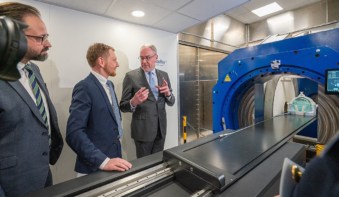
While X-ray imaging is routinely employed in medical diagnosis and in industry for inspecting materials like semiconductors for defects, existing X-ray machines cannot image curved three-dimensional objects with high resolution. A team led by researchers at the National University of Singapore (NUS) and Fuzhou University in China has now developed a new flexible X-ray sensor that can do just this. The device, which relies on a series of nanoparticles that emit light for a long time after being excited with X-rays – a phenomenon known as persistent radioluminescence – might find use in healthcare applications such as portable X-ray detectors for mammography and imaging-guided therapeutics.
The X-ray detectors in today’s X-ray machines are usually flat panels in which each pixel has its own integrated circuit. This set-up makes the pixels bulky and limits the resolution of the detector, explains team member Xiaogang Liu at the NUS’ Department of Chemistry. The panels’ flatness also means the detectors struggle to capture images of curved objects.
Wrap-around device
In their work, Liu and colleagues focused on lanthanide-doped nanomaterials, which have unique luminescent properties that are already widely exploited in X-ray scintillation, optical imaging, biosensing and optoelectronics. They began by doping sodium lutetium fluoride (NaLuF4) nanocrystals with ions of the rare-earth element terbium (Tb3+). They then embedded the doped nanocrystals (which are denoted as NaLuF4:Tb@NaYF4) into silicone rubber to make a highly flexible X-ray detector that can be wrapped around 3D objects.
The next step was to excite the NaLuF4:Tb@NaYF4 with X-rays at an energy of 50 kV. When they did this, the team observed that the material emitted intense light long after the source of X-rays had been removed. The light persisted for more than 30 days, which means it can be used to image objects throughout this time.
Slow “hopping” charge carriers
Liu and colleagues explain that the light is emitted as the lutetium ions in the NaLuF4:Tb@NaYF4 lattice absorb the energy of the X-rays, generating many energetic electrons in the process. When X-ray photons collide with small fluoride ions in the material, flaws known as anion Frenkel defects form in the nanocrystal and trap the energetic charge carriers (electrons and holes) created. The prolonged radioluminescence in the material comes from these electrons slowly “hopping” through the crystal scaffold towards the Tb3+ ions and radiatively recombining with hole-Tb3+ centres, they say.
Liu acknowledges that other persistently luminescent materials already exist. Phosphors are one prominent example, and in 2011 a team at the University of Georgia, US, reported that ZnGa2O4:Cr3+ phosphors have an afterglow lifetime of approximately 15 days. However, Liu notes that these other materials are either not very sensitive to X-rays or are difficult to manufacture at the nanoscale, which makes them unsuitable for making flexible detectors.
Sub 25-micron image resolution
The NUS team’s imaging technique, which they call X-ray luminescence extension imaging (Xr-LEI), can be used to produce images with a resolution of less than 25 micrometres, the researchers say. “Many research groups, including ours, have been taking on challenges in X-ray imaging over the past few years,” Liu notes. “The technology we report on may provide a much-needed solution for imaging highly-curved 3D objects. It could be particularly suitable for applications like point-of-care X-ray radiography and screening mammography without having to compress the breast, which is uncomfortable for the patient.”

3D printing perovskites onto graphene creates ultrasensitive X-ray detector
As well as healthcare applications, the technique might also be used to detect defects in electronic materials like semiconductors, authenticate works of art and to examine archaeological objects at the micron scale, he adds.
The researchers, who report their work in Nature, say they now plan to optimize the performance of their persistent luminescent nanomaterials to further reduce X-ray dosage and exposure time. “We will also be pursuing the development of dynamic X-ray imaging techniques that would benefit real-time monitoring of biological processes of living organisms,” Liu tells Physics World.



